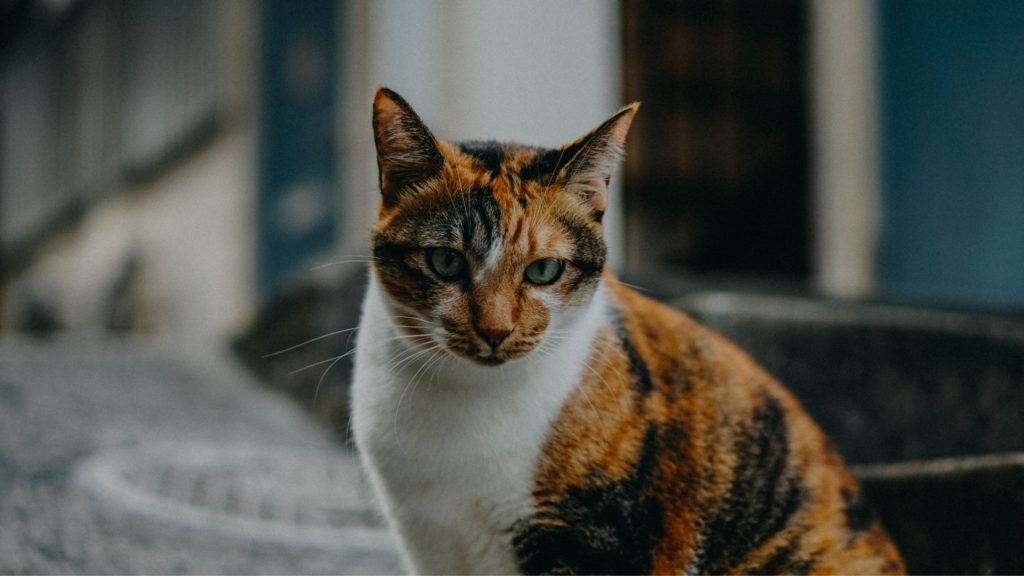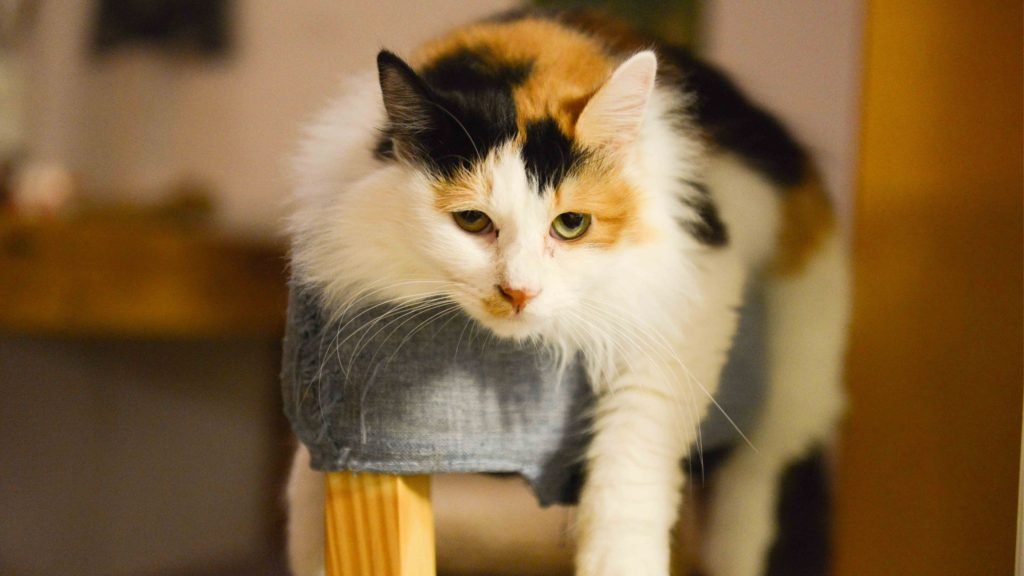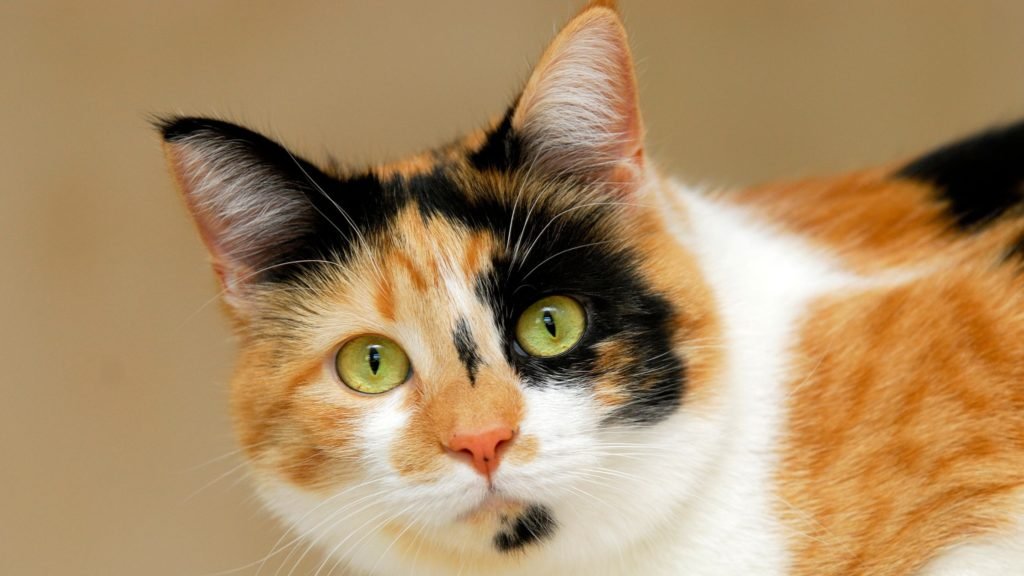Do Calico cats shed? Get ready to explore Calico shedding patterns, uncover factors affecting their fur loss, and learn how to keep their coats looking fabulous.
Calico cats boast unique, vibrant coats. These felines flaunt a mix of colors, typically white, black, and orange. Most Calico cats are female, thanks to the genetics governing their distinct coat pattern.
The Artful Calico Pattern
Calico coats display a striking blend of hues. Patches of white, black, and orange intermingle, creating a one-of-a-kind design. The Calico pattern is visually intriguing, making these cats a favorite among feline lovers.
Shedding Secrets: Calico Cats Unraveled
This outline seeks to explore shedding in Calico cats. Delve into factors affecting shedding, grooming requirements, and health considerations related to these colorful felines. Shed light on the mysteries of Calico cat shedding and learn how to keep your furry friend in tip-top shape.

You May Also Interest: Why Your Cat is Getting Hairballs and How to Prevent Them
Calico Coat Features
Calico Coats: Fluff & Finesse.
The coats of calico cats range in length and texture. Some exhibit short, sleek coats, while others flaunt long, silky locks. Regardless, these felines always impress with their remarkable coats.
Kaleidoscope of Colors.
Calico coats showcase an eye-catching array of colors. White typically dominates, with black and orange patches sprinkled throughout. Each Calico cat’s fur is unique, ensuring no two are identical.
Calico Genetics: Nature’s Palette.
Genetics plays a vital role in determining a Calico cat’s coat. The X chromosome carries the genes responsible for coat color. Females with two X chromosomes are likelier to display the signature Calico pattern. In contrast, male Calico cats are rare and often sterile due to an unusual genetic makeup.
Shedding in Cats
- Factors affecting shedding
- Seasonal shedding
Seasonal Swaps: Fur Galore.
Cats shed fur in response to seasonal changes. As the days grow longer, they shed their winter coats. Conversely, they lose their summer coats as daylight hours wane.
Hormones & Hairballs: A Furry Affair.
Hormones can influence shedding in cats. Spaying or neutering may affect hormone levels, potentially altering relieving patterns in some felines.
Well-fed Whiskers: The Hair Factor.
A balanced diet and proper hydration promote a healthy coat. Conversely, inadequate nutrition or illness may lead to excessive shedding.
Do Calico Cats Shed?: A Breed Comparison.
Shedding varies among cat breeds. Some, like the Siamese, shed minimally. Others, like the Maine Coon, shed more profusely. Calico cats’ shedding patterns depend on their specific coat type and breed genetics.

You May Also Interest: Bengal Cat Hypoallergenic: Embrace Feline Love Without Allergie
Do Calico Cats Shed?: Shedding in Calico Cats
Calico Quirks: Shedding Shenanigans.
Calico cats’ shedding patterns depend on their coat type. Short-haired Calicos tend to shed moderately, while long-haired Calicos might shed more heavily, especially during seasonal transitions. As the seasons change, Calico cats may experience increased shedding to prepare for warmer or colder weather. Expect increased shedding in spring and fall as your cat’s coat adapts to the fluctuating temperatures.
Calico Cats: The Shedding Spectrum.
Various factors influence shedding in Calico cats, including:
- Coat type: The length and thickness of a Calico cat’s fur impact shedding levels. Long-haired Calicos typically shed more than their short-haired counterparts.
- Genetics: The breed mix of a Calico cat may affect shedding tendencies, as some breeds are prone to heavier shedding than others.
- Overall health: A healthy cat is less likely to experience excessive shedding. Ensure your Calico cat receives proper care to maintain optimal health.
- Seasonal changes: As mentioned earlier, shedding increases during seasonal transitions.
- Hormonal changes: Hormonal imbalances, often resulting from medical issues or altered reproductive status, can influence shedding patterns.
- Managing shedding in Calico cats
Taming the Tumbleweeds: Calico Coat Care.
Proper grooming and care help manage shedding in Calico cats. Here are some tips to keep your cat’s coat in optimal condition:
- Regular brushing: Brush your Calico cat several times weekly to remove loose fur, reduce shedding, and prevent matting. Use a brush or comb suited to your cat’s coat type for the best results.
- Balanced diet: A nutritious diet, rich in essential nutrients, supports a healthy coat, and minimizes shedding. Consult your veterinarian to determine the ideal diet for your cat’s needs.
- Hydration: Ensure your cat has access to clean, fresh water. Proper hydration contributes to a healthy coat and overall well-being.
- Environment: Maintain a clean, stress-free environment to promote overall health and minimize factors that could lead to increased shedding.
- Vet check-ups: Regular veterinary visits help identify and address any underlying health issues that may contribute to excessive shedding. Annual check-ups and vaccinations are essential to keep your Calico cat in peak condition.

You May Also Interest: Cat Breeds That Don’t Shed: The World of Low-Shedding Felines
Do Calico Cats Shed? Grooming and Maintenance
- Grooming requirements for Calico cats
- Fur maintenance
Calico Couture: Fur Flair.
Fur maintenance is vital for Calico cats to keep their particular coat looking their best. Regular brushing removes loose hair, prevents tangles and mats, and distributes natural oils throughout the skin, enhancing its shine and health. Daily brushing may be required for long-haired Calicos, while short-haired Calicos may only need brushing 2-3 times per week.
Calico Claws: Nail Necessities.
Trimming your Calico cat’s nails every 2-3 weeks helps prevent overgrowth, leading to discomfort, difficulty walking, and potential injuries. Regular nail trimming also reduces the risk of damage to furniture, carpets, and other household items. Introducing nail trimming makes the process easier for you and your cat.
Calico Care: Ear Essentials.
Cleaning your Calico cat’s ears as needed helps prevent wax buildup, odors, and potential infections. Inspect your cat’s ears weekly and gently clean them with a soft cloth or cotton ball moistened with a vet-approved ear cleaner. Avoid using cotton swabs, which can damage the delicate inner ear structures.
Brush & Buff: Calico Coat Control.
Brushing your Calico cat several times a week minimizes shedding, promotes a healthy coat, and reduces hairballs. Choose a brush or comb designed for your cat’s coat type to achieve the best results.
Do Calico Cats Shed?: Bath-time Benefits.
Occasional baths help remove excess hair and dander, reducing shedding in Calico cats. Bathing your cat every 4-6 weeks using a gentle, cat-specific shampoo can help maintain a clean and healthy coat. Ensure you thoroughly rinse and dry your cat afterward to prevent skin irritation or chills.
Calico Cuisine: Feeding Finesse.
A balanced diet, rich in essential nutrients like protein, healthy fats, vitamins, and minerals, supports a healthy coat and minimizes shedding in Calico cats. High-quality cat food, either wet or dry, can provide these essential nutrients. Consult your veterinarian for personalized recommendations based on your cat’s age, weight, and activity level. Always keep fresh water available to keep your cat well-hydrated and support overall health.
You May Also Interest: Maine Coon Bombay Mix Magic: A Feline Fusion to Adore
Health Considerations Related to Shedding
Do Calico Cats Shed?: Health-Linked Shedding.
Specific health issues can contribute to excessive shedding in cats, including:
- Allergies: Environmental or food allergies may increase shedding, itching, and skin irritation.
- Parasites: Fleas, ticks, and mites can cause itching, skin damage, and excessive hair loss.
- Hormonal imbalances: Conditions like hyperthyroidism or Cushing’s disease can impact a cat’s coat and shedding patterns.
- Nutritional deficiencies: An inadequate diet lacking essential nutrients can result in poor coat quality and increased shedding.
- Stress: Emotional stress and anxiety may cause excessive grooming and hair loss in some cats.
- When to consult a veterinarian
Vet Visits: Timely Check-ins for Tresses.
Consult your veterinarian if you notice any of the following signs related to your cat’s shedding:
- Sudden, excessive hair loss.
- Bald patches or thinning fur.
- Persistent itching or scratching.
- Skin irritation, redness, or inflammation.
- Changes in grooming habits, such as overgrooming or lack of self-grooming.
These symptoms may indicate an underlying health issue that requires professional attention and treatment.
Do Calico Cats Shed? Proactive Protection
Preventive care and regular check-ups are essential for maintaining your cat’s overall health and minimizing shedding-related issues. Implement the following practices to keep your cat’s coat and health in top shape:
- Annual vet visits: Schedule regular check-ups to ensure early detection and treatment of potential health concerns.
- Vaccinations: Keep your cat’s vaccinations up-to-date to protect them from infectious diseases.
- Parasite control: Administer flea, tick, and heartworm preventives as your veterinarian recommends.
- Diet and nutrition: A balanced diet supports a healthy coat and well-being. Consult your veterinarian for personalized feeding recommendations.
- Grooming: Regular grooming helps maintain coat health, reduces shedding, and allows you to monitor your cat’s skin condition closely.

